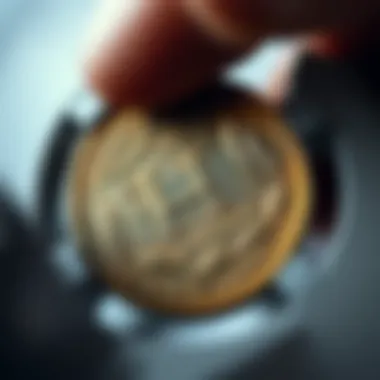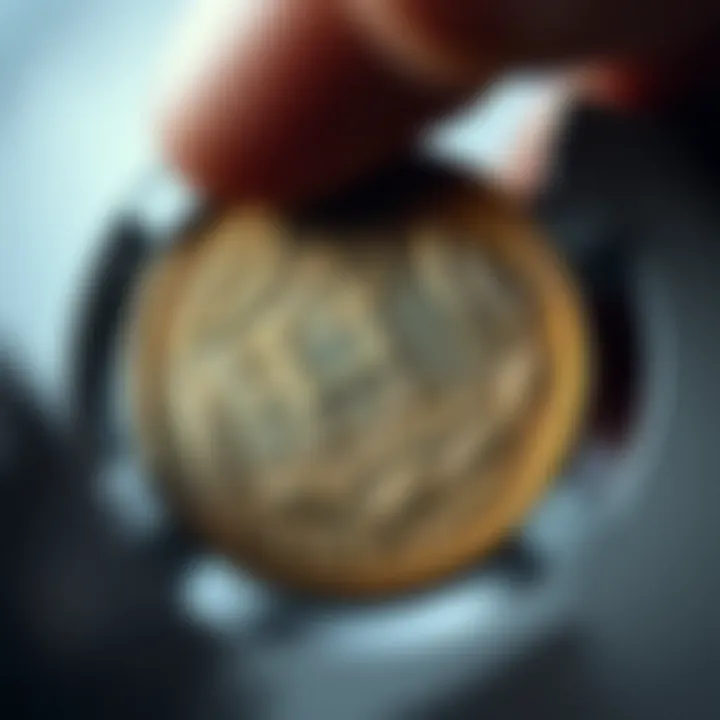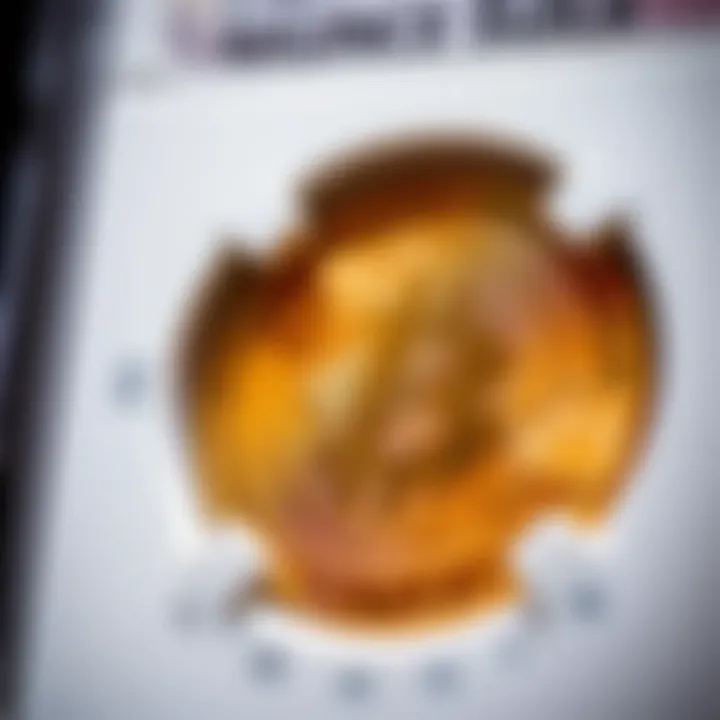Understanding NGC Coin Values: A Comprehensive Guide


Intro
Navigating the world of coin collecting can feel like stepping into a treasure trove filled with the surprises of history and value. When it comes to understanding the worth of coins, specifically those assessed by the Numismatic Guaranty Corporation (NGC), complexity reigns. This guide serves to unpack the intricacies surrounding NGC coin values, providing insight for seasoned collectors and newcomers alike.
The NGC has long been recognized as a leading authority in coin grading and certification. Their assessments help establish a common ground for buyers and sellers, ensuring transparency in a market that can often bewilder even the most seasoned investors. Whether you are deliberating over an ancient Roman coin or a modern piece, the factors affecting their value are multi-faceted. This guide will cover not just what impacts coin values, but also how to effectively wield that knowledge in your investing endeavors.
As we embark on this exploration, anticipate discussions about the various aspects that influence grading, the pressing relevance of certification, the ebbs and flows of market trends, and practical strategies to enhance your collecting experience. Coinage isn't just about the metal; it's about the story each piece tells.
"The value of a coin isn't just measured in dollars but in its history and place in time."
By the end of this guide, you will ensure you are well-equipped to approach the NGC coin market with confidence, turning what can be an overwhelming experience into an engaging and profitable venture.
The Role of NGC in Coin Grading
When it comes to the world of numismatics, the Numismatic Guaranty Corporation (NGC) holds a pivotal role in shaping perceptions about coin values. Grading is not just a mere formality; it’s the foundation upon which collectors and investors base their decisions. Understanding the role of NGC in this intricate process not only helps enthusiasts appreciate their collections but also empowers them to make informed financial choices.
The presence of a recognized grading service like NGC adds a layer of credibility to the coin market. It establishes a standard that both buyers and sellers can rely on, ensuring a level playing field. Without such an authority, determining the actual worth of a coin could become as subjective as a person’s taste in art—each collector having their own perspective without a common language to bridge understanding. Thus, NGC’s grading services emerge as a linchpin in the complex machinery of coin valuation.
History of NGC
The story of NGC dates back to its founding in 1987. Like many good ventures, it sprouted from a passion that quickly blossomed into a necessity. Coin collectors and dealers were facing challenges with counterfeit coins and inflated values based on anecdotal evidence rather than hard facts.
With a commitment to set the record straight, NGC introduced an authoritative grading scale. They became pioneers in using a scientific approach to grading, relying on professional numismatists with extensive training. This foundation laid a bedrock of trust that catapulted NGC into the forefront of the coin grading industry. As of today, NGC has graded millions of coins worldwide, reinforcing its reputation.
Importance of Grading Services
The importance of grading services extends beyond mere aesthetics or personal satisfaction. It acts as a comprehensive assurance for both the collector and the market.
- Rarity: Grading helps establish a coin's rarity. Coins evaluated by NGC often come with detailed information about their mintage and condition, which assists collectors in identifying rare pieces that might be the crown jewels of their collections.
- Market Reliability: In an ever-evolving market where values can fluctuate like a roller coaster, having an NGC grade can stabilize expectations. Investors are more likely to pay top dollar for coins that come with a reliable grading seal, knowing it reflects quality and authenticity.
- Future Investments: For those looking to invest, a high-grade coin from NGC can be seen as a safer bet. A coin that is graded higher not only tends to be more sought after but also holds its value better over time. Hence, the decision to choose coins that are graded by reputable services can yield fruitful returns.
In short, the grading conducted by NGC serves as a compass in the vast ocean of coin collecting. The journey of understanding coin values starts here, as it guides collectors and investors alike toward making informed decisions in what can be a treacherous market.
Understanding Coin Values
Understanding the concept of coin values is a linchpin in the realm of numismatics. It not only influences collectors' purchasing decisions but also informs investors about potential returns on their investments. This section delves into the intricacies of coin values, breaking down the components that determine worth and emphasizing their significance for anyone involved in the coin market.
Factors Influencing Coin Values
When it comes to assessing the worth of coins, three primary factors play a substantial role: Rarity, Condition, and Market Demand. Each of these elements interplays with the others, collectively painting a picture of a coin’s value in both the present market and the historical context.
Rarity
Rarity stands as one of the most pivotal aspects determining a coin's value. In numismatics, a coin's rarity is often gauged by how many were minted and how many still exist today. A unique or extremely low-mintage coin often fetches higher prices simply because there is less supply available to collectors. Consider the 1933 Saint-Gaudens $20 gold coin; its rarity stems from its complicated history and the fact that few were legally available, making it a highly sought-after item in collectors' circles.
The relationship between rarity and value can be quite beneficial for collectors, as rare coins tend to appreciate over time. However, it’s essential to note that rarity alone does not guarantee high value; other factors must complement rarity to create a significant demand.
Condition
The condition of a coin is another critical element that shapes its valuation. This refers to the physical state of the coin, which is generally assessed using the grading system. Coins in pristine condition are valued higher compared to those with visible wear and tear. For example, a coin graded as MS-70, signifying perfect quality according to the NGC scale, has a substantially higher value than one graded as VF-20, which indicates significant wear.
The unique aspect of condition is how it intertwines with rarity. A rare coin in poor condition may not command high prices, while a common coin in excellent condition could be worth more. Thus, condition provides a multi-layered perspective on valuing coins, acting as both a potential boon and a hindrance.
Market Demand
Market demand is the third leg of the triad that influences coin values. Even the rarest or most well-preserved coins can falter in price without adequate demand. The popularity of certain coins can fluctuate based on trends, historical events, or even social media influences. For instance, coins from specific eras or events, like the Kennedy half-dollar, may spike in value due to increased interest during anniversaries or related media coverage.


An understanding of market demand helps collectors and investors gauge what coins might be lucrative over time. However, the disadvantage is an unpredictable nature of trends; today’s hot collectible can be tomorrow’s novelty. Staying attuned to current events and collector interests can provide an edge in navigating coin accumulation and investment opportunities.
The Grading Scale
The grading scale serves as another fundamental aspect in determining a coin's value. Generally, coins are assessed according to their physical characteristics and assigned a grade that reflects their condition.
High-Grade Coins
High-grade coins are often the jewels of any collection. They are marked by their near-perfect condition, with minimal signs of wear. Collectors specifically seek high-grade coins because they hold greater aesthetic appeal and potential investment returns. Such coins typically belong to the upper echelons of the grading spectrum, often receiving ratings from NGC that classify them as part of the elite.
The unique feature of high-grade coins entails not just their aesthetic quality, but also their desirability in auctions. However, one must exercise caution as their elevated price tags can be daunting to new collectors. Investing rather heavily in high-grade coins necessitates understanding what makes these coins stand out beyond their grades alone.
Lower-Grade Coins
On the opposite end of the spectrum are lower-grade coins. While these may not shine as brightly in terms of condition, they can often be more affordable options for beginning collectors or those looking to invest with lesser upfront costs. Lower-grade coins can still be valuable in terms of historical context or rarity, but they may require collector expertise to truly understand their worth.
A unique feature of these coins is their accessibility. They allow newcomers to enter the numismatic world without breaking the bank. However, collectors must be mindful; acquiring lower-grade coins en masse doesn’t always translate into a lucrative investment. Thus, understanding their potential value alongside higher-grade counterparts is imperative for optimal investment returns.
The Certification Process
In the world of coin collecting, certification is not just a formality; it’s the backbone that supports the integrity and value of a coin. The certification process involves a meticulous evaluation conducted by professionals who assess various attributes such as the coin's age, condition, and authenticity. As collectors and investors, understanding this process is crucial for making informed decisions. It establishes trust among buyers and sellers, ensuring that the coins exchanged in the market hold true value based on standardized criteria.
How Coins are Rated
When it comes to coin rating, experts meticulously examine coins under magnification, looking for minute details that affect their grade. The grading system usually ranges from poor to perfect, and it considers factors like luster, strike quality, and any wear or damage.
- Rarity: A coin's scarcity can significantly influence its grade. The fewer coins there are in circulation, the more valuable each one becomes.
- Condition: This encompasses the physical state of the coin. High-grade coins, which are well-preserved, typically fetch higher prices than their lower-graded counterparts that may show signs of wear.
- Market Demand: Collectors' interests can sway valuation. If a particular coin type gains popularity, its demand will climb, affecting overall value.
Every aspect matters during the rating, and nuances can mean the difference between a coin being classified as a rare find or just another piece in a collection.
Benefits of Certification
The advantages of having coins certified are manifold, offering peace of mind to collectors and investors alike. Let’s dive deep into two primary benefits:
Proof of Authenticity
Proof of Authenticity is what gives potential buyers confidence in their purchase. It’s one thing to own a coin; it’s another to have documentation that states it’s a legitimate specimen. This aspect acts as a safety net for collectors who invest significant funds in rare coins. The key characteristic that stands out is that an NGC certification acts not only as a guard against counterfeits but also provides a detailed account regarding the coin's condition and history. This evidence becomes a compelling selling point should the owner decide to liquidate their assets down the line. However, it’s important to note that not all certifications are equal—some grading services may vary in reputation and reliability.
Investment Security
On the front of Investment Security, certified coins provide a layer of assurance that unmanaged assets cannot match. When you hold a certified coin, you’re not just holding a piece of history; you’re holding a potential investment that retains its value, or often appreciates over time. In contrast to unverified coins, graded coins tend to abide by market demand more reliably, providing more predictable returns. A unique feature of investing in certified coins is the lower risk involved, as legitimate certificates discourage fraud and misrepresentation. This means that an educated investor can comfortably navigate the landscape knowing exactly what is in their portfolio.
However, it’s worth remembering that while certified coins are generally a sound investment, the market can still be subject to fluctuations. Being aware of these variables and utilizing certification as a tool can greatly enhance your investment strategy.
"Investing in certified coins is less about just owning collectibles and more about ensuring you have valuable assets in your hands."
As we attempt to understand the overall dynamics surrounding coin collecting and investing, the certification process remains a vital component in navigating this captivating market.
Current Market Trends in Coin Collecting
The world of coin collecting is far from static; it evolves with each beat of the economic drum. Understanding the current market trends is crucial for anyone looking to invest wisely in coins. This section sheds light on what's buzzing in the coin collecting community and why these trends matter.
Emerging Trends
In recent times, there have been noticeable shifts in how collectors engage with coins. Notably, the rise of digital platforms has changed the landscape dramatically. Buying and selling coins online through websites like eBay and specialized auction sites has become the norm. Here, collectors can find rare coins without the need for a physical marketplace. This shift not only expands the variety of coins available but also makes it easier for new collectors to get their feet wet.


Additionally, the demand for coins that reflect modern culture, such as those related to popular movies or significant historical events, has spiked. Collectors are increasingly looking to add these unique items to their collections. With special editions and commemorative coins hitting the market, it’s important for collectors to keep their ears to the ground, ensuring they catch these fleeting opportunities.
Furthermore, younger generations are entering the hobby, looking toward social media for inspiration and community. Platforms like Instagram and TikTok showcase stunning collections and enable knowledge-sharing that previously relied on face-to-face interaction at coin shows. This influx of interest from younger collectors enhances the overall vitality of the market.
Market Analysis
Supply vs. Demand
When discussing supply and demand in the coin market, it becomes apparent how intertwined these factors are. Generally, if a specific coin is rare but there are many collectors wanting it, the price can climb quicker than gas prices in summer. Conversely, if supply overwhelms demand, prices tend to slide. A particular instance is when a large minting run is issued.
As collectors, being in tune with this dance of supply and demand can provide valuable insights when making purchasing decisions. For instance, during a coin fair, if a rare 1933 Saint-Gaudens Double Eagle appears and collectors swarm around it, that’s your cue — that demand is high, and the price likely will reflect that. If you're on the lookout for investments, identifying coins with low supply and high demand can offer a profitable path.
“In the coin market, savvy investors understand that supply and demand dictate value — it's a compass to guide your collection.”
Price Fluctuations
Price fluctuations in the coin market can sometimes resemble a yo-yo — up one moment, down the next. These changes can stem from various factors, such as shifts in collectors’ interests or broader economic trends. For instance, during economic downturns, even collectible coins may take a hit, as people tighten their belts and stop splurging on luxury items. Yet, some coins, particularly precious metal coins, may see their prices soar as they become a refuge for investors fleeing from unstable markets.
Understanding how to navigate these price fluctuations is key. It's smart to keep an eye on market trends over time rather than rely on a single sale to dictate value. This approach helps collectors still feel confident in their long-term investments.
The ability to assess trends effectively can either empower a collector to invest wisely or lead them down a rabbit hole of impulsive decision-making. Staying informed about the economic backdrop is not just smart; it’s essential in maintaining a strong investment portfolio in coin collecting.
Investing in Graded Coins
When it comes to building a collection that not only catches the eye but also holds value, investing in graded coins positions collectors and investors alike to reap potential gains. Graded coins simply mean that they’ve been evaluated and certified by an organization, like the Numismatic Guaranty Corporation, assessing their condition, authenticity, and overall worth. The significance of this process cannot be overstated, especially in a market where the subtleties of value can spell the difference between a smart investment and a costly blunder.
Investing in graded coins has several critical aspects that are worth exploring. For one, the grading system provides a level of standardization that helps to mitigate risks. This protects investors from investing in coins that may be misrepresented. A coin graded as "MS-70" is not just a piece of metal; it is a standard that conveys a level of quality and subsequent worth recognized universally.
Moreover, a clear understanding of graded coins can help collectors pinpoint areas where they can potentially earn returns. The trend for graded coins is upward; as younger generations enter the market, many are drawn into the realm of numismatics due to the allure of tangible investments. This growing interest inevitably pushes demand, creating a fertile ground for savvy investors.
Beyond aesthetics and desirability, there's also the financial protection to consider. Coins in good to excellent condition generally retain their value over time, often more than ungraded coins. Additionally, graded coins are easier to sell in established marketplaces, and collectors tend to offer better prices for coins with certification, knowing they are less likely to encounter counterfeit issues.
Identifying Rare Opportunities
Finding rare coins that have been graded can feel like searching for a needle in a haystack, but it's a thrilling hunt. The key lies in understanding market trends, coin histories, and the factors that contribute to a coin’s rarity.
To identify those coveted rare opportunities:
- Research Provenance: Coins with a well-documented history tend to appreciate more. Understand where your coin originated, the previous owners, and its journey through time.
- Stay Informed: Join numismatic forums and communities on platforms like Reddit, where collectors and investors share insights. Familiarize yourself with auction houses, such as Heritage Auctions or Stack’s Bowers.
- Attend Coin Shows: Events such as the American Numismatic Association’s annual convention present a chance to mingle with seasoned collectors. Knowledge and tips shared at these gatherings can lead to discovering rare finds.
"Graded coins often reflect not just monetary worth, but also a unique story. Understanding that narrative can transform simple collection into a lucrative investment."
Long-Term vs. Short-Term Investments
Partitioning investment strategies into long-term and short-term perspectives is crucial. Coin investing can cater to both viewpoints, but each approach comes with its own set of considerations.
- Long-Term Investments: This is often seen as the safer route. Investments in coins, especially those that are already graded, usually appreciate over years. A collector who formerly bought a collection of commemorative coins from the U.S. Mint can find their value multiply a decade later, especially if the coins have maintained or improved their condition. Understanding the intrinsic historical value is imperative; this offers not just monetary gain but personal satisfaction as well.
- Short-Term Investments: Quick flips in the coin market can yield rewards, but they come with challenges. For instance, one might seize an opportunity when bidding on a rare coin and then sell it off quickly when demand is ripe. Timing becomes essential here, and market knowledge or sometimes the right gut feeling can make the difference. Keeping an eye on graded coins at auctions, where enthusiasm can push prices up, becomes critical for short sales.
Before diving into which strategy suits you best, it's important to weigh the benefits against your goals and risk tolerance. Are you in it for passion, or are you looking to strike gold? Knowing the answer will guide you toward a pathway in the coin investment world.
Challenges in the Coin Market
In the intricate world of coin collecting, challenges can frequently set the stage for a daunting journey. Coin enthusiasts must navigate issues such as counterfeits and market saturation, both of which pose significant hurdles for investors and collectors alike. Understanding these challenges is vital for anyone looking to venture into or enhance their experience in the realm of numismatics.
Counterfeit Coins


Indicators of Authenticity
Counterfeit coins represent a significant concern within the coin market. Identifying indicators of authenticity is not just beneficial; it's essential. An authentic coin usually has distinct marks, weight, and a certain feel that counterfeits fail to replicate accurately. For instance, a genuine coin's edge may exhibit a specific milling pattern that is absent or poorly imitated in a forgery. Such characteristics are helpful tools for collectors and investors, allowing them to filter out fraudulent offerings from legitimate ones. Moreover, the presence of an official grading certificate from NGC can further bolster confidence in a coin’s authenticity.
One must also be cautious not to rely solely on visual inspection. Some counterfeiters produce pretty convincing fakes that can easily mislead the untrained eye. Herein lies the advantage of third-party grading services, which provide an unbiased evaluation of a coin's authenticity. Recognizing the right indicators of authenticity becomes paramount, especially when significant investments are at stake. A keen eye for detail can save collectors from costly mistakes.
Preventative Measures
The fight against counterfeit coins isn't just about detection; it also involves implementing preventative measures. One important step is sourcing coins from reputable dealers. This ensures a trustworthy transaction where the likelihood of encountering a counterfeit is significantly reduced. Furthermore, staying educated on the latest trends in counterfeiting can keep collectors a step ahead. For example, certain types of coins have become the target of counterfeiters due to their popularity and demand. Knowing which coins are frequently faked can inform buying decisions.
Another effective preventative measure is the use of technology like digital scanning and blockchain verification to track a coin’s provenance. These methods offer a unique solution by embedding authenticity information into the coin's data profile, helping to ensure that buyers can securely verify the coin's history and legitimacy. However, these technologies may not be widely adopted yet, limiting their immediate effectiveness for everyday collectors. As technologies evolve, adopting these measures could become standard practice in the market.
Market Saturation
Market saturation is another issue that can lead to complications in the collecting ecosystem. As more individuals become interested in coin collecting, the market can become flooded with coins, many of which are lower quality or common varieties. This influx can lead to diminished values for numerous coins. Investors need to be astute, recognizing that just because more coins are entering the market, it doesn't mean that the value of all coins will rise.
A saturation environment can create difficulties for those looking to sell their coins. In a crowded marketplace, buyers may be more selective, leading to increased competition among sellers. Moreover, coins that were once rare might begin to lose their luster as their availability rises.
In essence, navigating these challenges requires a blend of knowledge, patience, and diligence. For investors and collectors, being aware of the potential pitfalls can safeguard their investments and enhance their appreciation for the complexities of the coin market.
The Future of Coin Collecting and NGC
As we look toward the horizon of coin collecting, the role of the Numismatic Guaranty Corporation (NGC) continues to evolve. The significance of both NGC and the coin collecting community is amplified by a rapidly changing landscape fueled by technology, shifting market preferences, and the enduring allure of rare coins. With new advancements and predictions shaping the future, it’s essential to reflect on what this means for investors and collectors alike.
Technological Advances
The rise in technology presents a host of new opportunities and challenges for coin collectors. One of the most prominent innovations is the use of blockchain technology. By providing a transparent and secure ledger for tracking ownership, blockchain enables collectors to trace the provenance of their coins. This level of transparency can vastly reduce the risk of counterfeiting—a significant concern in the market today. Moreover, companies like NGC are beginning to leverage augmented reality (AR) and virtual reality (VR) to enhance the collecting experience. Imagine donning a pair of VR goggles and viewing a graded coin in a 360-degree format before making a purchase. Such technologies could revolutionize how collectors interact with coins, allowing for a detailed view beyond mere photographs.
In addition, new grading technologies, such as advanced imaging systems, are paving the way for more accurate evaluations. These systems can analyze minute surface details that the human eye might miss. As a result, coins may undergo more consistent grading standards, helping investors and collectors make informed decisions based on precise data.
Predictions for Market Evolution
Looking ahead, there are several key predictions about how the coin market may evolve. One notable trend is the increasing appeal of collectibles among younger generations. Millennials and Gen Z are beginning to view coins not merely as artifacts but as investment vehicles. This shift could contribute to an uptick in demand for graded coins, as younger collectors seek verified and authentic pieces for their portfolios.
Furthermore, as the market matures, the importance of diversification will likely become more pronounced. Collectors might broaden their horizons beyond traditional coins, branching into themed collections or historical pieces that resonate with personal interests. This will encourage auction houses and dealers to cater to niche markets, allowing investors to find unique opportunities that may yield significant returns.
Another prediction revolves around the impact of economic fluctuation. As inflation and market instability send ripples through traditional investment avenues, coins—being tangible assets—may become increasingly attractive as a hedge against financial uncertainty. As investors seek avenues that provide both value retention and growth potential, coins certified by NGC should remain at the forefront of their considerations.
"Understanding where the market is heading involves more than just keeping your ear to the ground—it’s about connecting the dots in the broader economic picture."
In summary, the future of coin collecting under the watchful eye of NGC is poised for transformation. Embracing technological advancements and adapting to market dynamics will be crucial for both collectors and investors. In this ever-evolving landscape, knowledge and foresight will position individuals to navigate the complexities of the coin market effectively.
Closure
As we draw the curtain on this comprehensive guide, it is essential to reflect on the intricacies of NGC coin values and how they intertwine with the broader landscape of numismatics. The conclusion is not merely a wrap-up; it serves as a critical junction that crystallizes our insights into a cohesive understanding of the topic at hand.
Summation of Key Points
The journey through the world of NGC coin values reveals several important ideas:
- Role of Grading: Grading, as performed by the NGC, is fundamental. It facilitates not only the valuation of coins but also fosters trust among buyers and sellers, which is invaluable in the often murky waters of coin collecting.
- Factors Influencing Value: Rarity, condition, and market demand stand as the pillars upon which coin values rest. Each element plays a vital role in whether a coin will appreciate or depreciate in value over time.
- Certification Process: The certification process by NGC provides an added layer of security. Knowing that a coin has been evaluated and certified can alleviate concerns regarding authenticity, safeguarding investments.
- Market Trends: Understanding current market trends is crucial for any investor. The coin market is fluid and can be impacted by various factors, from economic conditions to cultural shifts.
- Investment Strategies: Awareness of both long-term and short-term strategies can help investors navigate the complexities of collecting and trading coins.
Final Thoughts on Coin Values
To wrap it up, understanding NGC coin values extends beyond simple numbers on a price tag. It involves diving deep into a world where history meets economics, and aesthetics collide with value. For the seasoned collector or the curious novice, each aspect of the coin—its rarity, condition, and market narrative—plays a part in telling its story.
So, whether you're assessing a coin for investment or appreciate its artistic and historical significance, grasping these concepts will equip you with knowledge that transcends the surface. Investing in coins isn't just about making profits; it’s about building a deeper connection with history and art, one coin at a time.
Knowledge is the first step toward informed decisions in the coin market. Always stay curious.
In the end, the journey into coin values is one filled with possibilities, and as this guide outlines, the landscape is rich and ready for exploration.





